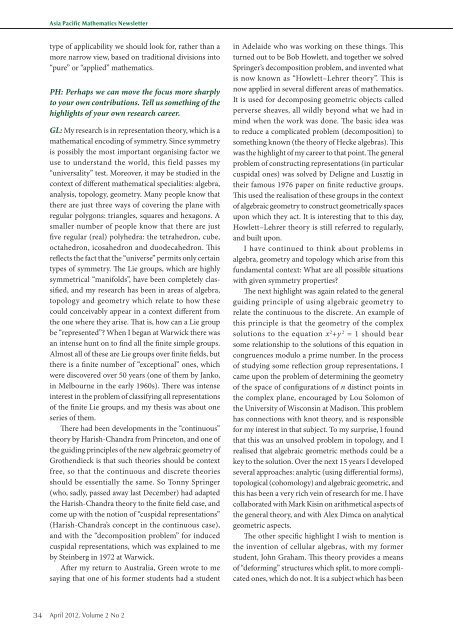Mathematics Newsletter
Mathematics Newsletter
Mathematics Newsletter
Create successful ePaper yourself
Turn your PDF publications into a flip-book with our unique Google optimized e-Paper software.
34<br />
Asia Pacific <strong>Mathematics</strong> <strong>Newsletter</strong><br />
type of applicability we should look for, rather than a<br />
more narrow view, based on traditional divisions into<br />
“pure” or “applied” mathematics.<br />
PH: Perhaps we can move the focus more sharply<br />
to your own contributions. Tell us something of the<br />
highlights of your own research career.<br />
GL: My research is in representation theory, which is a<br />
mathematical encoding of symmetry. Since symmetry<br />
is possibly the most important organising factor we<br />
use to understand the world, this field passes my<br />
“universality” test. Moreover, it may be studied in the<br />
context of different mathematical specialities: algebra,<br />
analysis, topology, geometry. Many people know that<br />
there are just three ways of covering the plane with<br />
regular polygons: triangles, squares and hexagons. A<br />
smaller number of people know that there are just<br />
five regular (real) polyhedra: the tetrahedron, cube,<br />
octahedron, icosahedron and duodecahedron. This<br />
reflects the fact that the “universe” permits only certain<br />
types of symmetry. The Lie groups, which are highly<br />
symmetrical “manifolds”, have been completely classified,<br />
and my research has been in areas of algebra,<br />
topology and geometry which relate to how these<br />
could conceivably appear in a context different from<br />
the one where they arise. That is, how can a Lie group<br />
be “represented”? When I began at Warwick there was<br />
an intense hunt on to find all the finite simple groups.<br />
Almost all of these are Lie groups over finite fields, but<br />
there is a finite number of “exceptional” ones, which<br />
were discovered over 50 years (one of them by Janko,<br />
in Melbourne in the early 1960s). There was intense<br />
interest in the problem of classifying all representations<br />
of the finite Lie groups, and my thesis was about one<br />
series of them.<br />
There had been developments in the “continuous”<br />
theory by Harish-Chandra from Princeton, and one of<br />
the guiding principles of the new algebraic geometry of<br />
Grothendieck is that such theories should be context<br />
free, so that the continuous and discrete theories<br />
should be essentially the same. So Tonny Springer<br />
(who, sadly, passed away last December) had adapted<br />
the Harish-Chandra theory to the finite field case, and<br />
come up with the notion of “cuspidal representations”<br />
(Harish-Chandra’s concept in the continuous case),<br />
and with the “decomposition problem” for induced<br />
cuspidal representations, which was explained to me<br />
by Steinberg in 1972 at Warwick.<br />
After my return to Australia, Green wrote to me<br />
saying that one of his former students had a student<br />
April 2012, Volume 2 No 2<br />
in Adelaide who was working on these things. This<br />
turned out to be Bob Howlett, and together we solved<br />
Springer’s decomposition problem, and invented what<br />
is now known as “Howlett–Lehrer theory”. This is<br />
now applied in several different areas of mathematics.<br />
It is used for decomposing geometric objects called<br />
perverse sheaves, all wildly beyond what we had in<br />
mind when the work was done. The basic idea was<br />
to reduce a complicated problem (decomposition) to<br />
something known (the theory of Hecke algebras). This<br />
was the highlight of my career to that point. The general<br />
problem of constructing representations (in particular<br />
cuspidal ones) was solved by Deligne and Lusztig in<br />
their famous 1976 paper on finite reductive groups.<br />
This used the realisation of these groups in the context<br />
of algebraic geometry to construct geometrically spaces<br />
upon which they act. It is interesting that to this day,<br />
Howlett–Lehrer theory is still referred to regularly,<br />
and built upon.<br />
I have continued to think about problems in<br />
algebra, geometry and topology which arise from this<br />
fundamental context: What are all possible situations<br />
with given symmetry properties?<br />
The next highlight was again related to the general<br />
guiding principle of using algebraic geometry to<br />
relate the continuous to the discrete. An example of<br />
this principle is that the geometry of the complex<br />
solutions to the equation x 2 +y 2 = 1 should bear<br />
some relationship to the solutions of this equation in<br />
congruences modulo a prime number. In the process<br />
of studying some reflection group representations, I<br />
came upon the problem of determining the geometry<br />
of the space of configurations of n distinct points in<br />
the complex plane, encouraged by Lou Solomon of<br />
the University of Wisconsin at Madison. This problem<br />
has connections with knot theory, and is responsible<br />
for my interest in that subject. To my surprise, I found<br />
that this was an unsolved problem in topology, and I<br />
realised that algebraic geometric methods could be a<br />
key to the solution. Over the next 15 years I developed<br />
several approaches: analytic (using differential forms),<br />
topological (cohomology) and algebraic geometric, and<br />
this has been a very rich vein of research for me. I have<br />
collaborated with Mark Kisin on arithmetical aspects of<br />
the general theory, and with Alex Dimca on analytical<br />
geometric aspects.<br />
The other specific highlight I wish to mention is<br />
the invention of cellular algebras, with my former<br />
student, John Graham. This theory provides a means<br />
of “deforming” structures which split, to more complicated<br />
ones, which do not. It is a subject which has been


